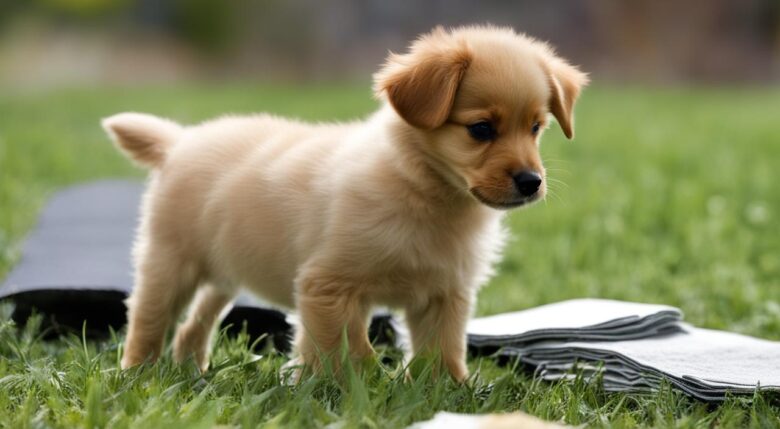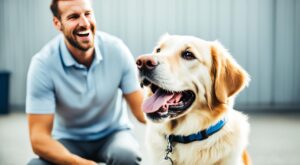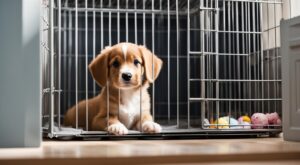Welcoming a new furry member into your home can be exciting, but it also brings new challenges, like potty training. Potty training your puppy is an essential part of pet ownership, both for ensuring a clean and tidy home and a healthy relationship with your pup. While it may seem daunting at first, with the right approach and consistency, you can successfully teach your puppy where to do their business.
In this section, we’ll cover easy steps to help you potty train your puppy fast and effectively, using positive reinforcement and practical strategies. Whether you’re a first-time pet owner or need a refresher, our guide will provide you with the tools and knowledge to succeed. So, let’s get started and say goodbye to accidents!
Key Takeaways:
- Potty training your puppy is essential for a happy and healthy pet-owner relationship.
- With the right approach and consistency, you can successfully potty train your puppy.
- Positive reinforcement and practical strategies are key to successful potty training.
- House training your puppy takes time and patience, but the results are worth it.
- Establishing a routine and using a designated potty area are crucial for effective potty training.
Understanding Puppy Potty Training
Potty training your puppy requires patience, consistency, and a basic understanding of your puppy’s behavior. Before starting the training process, it’s important to establish a routine and choose a designated potty area. A consistent routine helps your puppy understand when they should go outside and helps manage their behavior.
When selecting a designated potty area, consider your living situation. If you live in an apartment or have limited outdoor space, consider using puppy pads or litter boxes. If you have access to outdoor space, choose a grassy area that is easily accessible.
It’s important to set realistic expectations for your puppy’s progress. Potty training is a gradual process that takes time and effort. Be patient with your puppy, and provide positive reinforcement when they display good behavior.
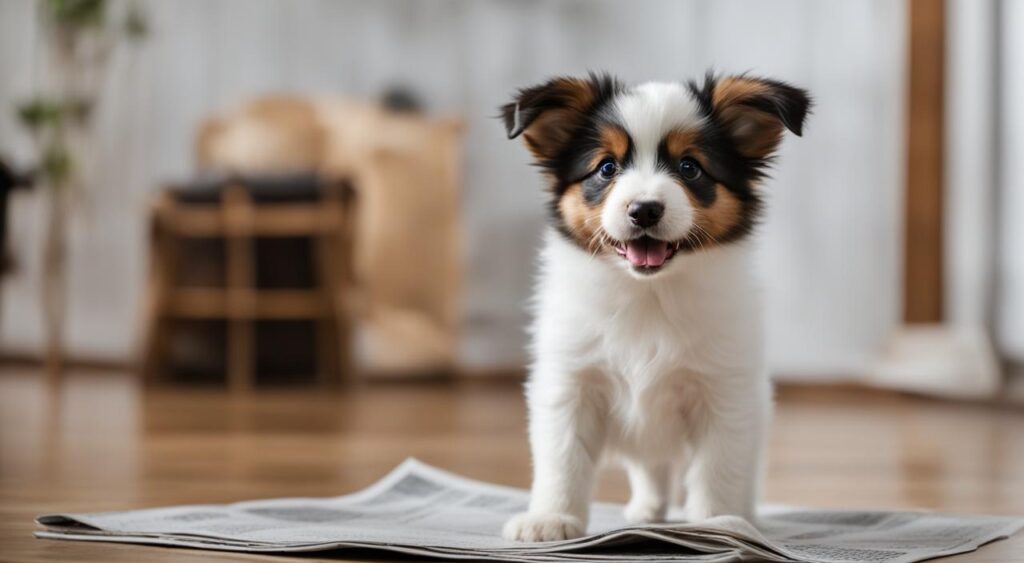
“The key to successful potty training is being consistent and establishing a routine. Every puppy is different, so it’s important to set realistic expectations and be patient with the process.”
There are several tips and tricks you can use to help make the potty training process easier and more effective. For example, crate training is a valuable tool that can help your puppy learn to control their bladder and bowels. Additionally, providing frequent potty breaks and using positive reinforcement are effective strategies for puppy potty training.
Tips for House Training a Puppy
Here are some tips to help you house train your puppy:
- Establish a consistent routine
- Choose a designated potty area
- Use positive reinforcement
- Provide frequent potty breaks
- Use crate training
- Be patient and consistent
Table: Choosing a Designated Potty Area for Your Puppy
| Living Situation | Potty Area |
|---|---|
| Apartment or Limited Outdoor Space | Puppy pads or litter box |
| Access to Outdoor Space | Grassy area |
Effective Strategies for Puppy Potty Training
When it comes to potty training your puppy, effective strategies can make all the difference. Here are some tips and techniques to help make your puppy potty training experience a success:
Positive Reinforcement
Positive reinforcement is a powerful tool in puppy potty training. Reward your puppy immediately after they successfully potty outside to reinforce good behavior. Verbal praise, petting, or treats can help create positive associations with going potty outside. Avoid punishing your puppy for accidents, as this can create fear and anxiety around the potty training process.
Crate Training
Many recommend crate training as a part of house training a puppy. The crate should be big enough for the puppy to stand up, turn around, and lie down comfortably, with a comfortable blanket or towel. Never use a crate as a punishment, but rather as a safe space for your puppy to relax and sleep. Puppies generally will avoid soiling their sleeping area, so the crate should be used as a tool to encourage regular potty breaks.
Potty Schedule
Set a regular potty schedule to encourage your puppy to establish a routine. Take your puppy outside to potty first thing in the morning, after meals, and before bedtime. Other opportunities to go outside include after playtime, excitement, or stress, as these can stimulate a puppy’s need to go.
Designated Potty Area
Choose a designated outdoor potty area for your puppy and take them there consistently. This will help them learn where to go when they need to eliminate. Use a specific phrase such as “go potty” to teach your puppy to associate this phrase with the act of going outside to potty.
Supervision
During the early stages of puppy potty training, supervision is crucial. Limit your puppy’s access to other areas in the house, and keep a close eye on them when they are inside. Watch for signs such as sniffing or circling, as these can indicate that your puppy needs to go outside.
Using a combination of these strategies, you can teach your puppy how to signal their need to go outside and avoid accidents indoors. Keep practicing these techniques with consistency, patience, and positivity, and you will achieve effective puppy potty training in no time!
Crate Training and Housebreaking Tips
Crate training your puppy can be an effective tool for toileting and housebreaking. A crate serves as your puppy’s den, providing them with a comfortable and secure space of their own. Here are some benefits of crate training that can help you potty train your puppy:
- Crates encourage good behavior and prevent destructive behavior, such as chewing and digging.
- Crates can be used to establish a routine for taking your puppy outside to potty.
- Crates provide a safe space for your puppy to retreat to when feeling anxious or overwhelmed.
When starting crate training, ensure that the crate is the appropriate size for your puppy and that it is placed in a quiet area. Use positive reinforcement by giving your puppy treats, toys or praise when they enter the crate and gradually increase the time that they spend inside. Once your puppy is comfortable with their crate, use it to help with housebreaking by following these tips:
- Select a designated potty area outside and take your puppy there frequently, including first thing in the morning and after meals.
- When your puppy shows signs of needing to go, such as sniffing around or circling, take them to the designated potty area immediately.
- Use a command such as “go potty” to help your puppy associate the cue with the behavior.
- If your puppy has an accident indoors, clean it thoroughly to eliminate the scent and prevent repeat accidents.
Remember to be patient and consistent with your puppy’s toileting and housebreaking. By using crate training and following these tips, you can successfully potty train your puppy and enjoy a clean and tidy home!
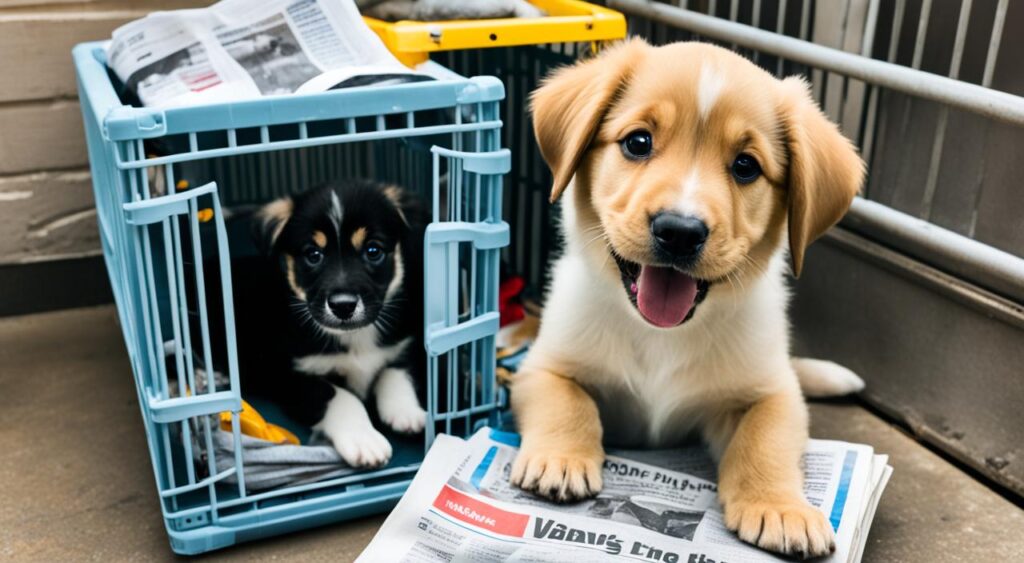
Conclusion
By now, you have learned how to potty train your puppy effectively and efficiently. Remember, patience, consistency, and positive reinforcement are essential for success.
Don’t get discouraged by accidents – they are a normal part of the process.
Stick to your routine and avoid punishing your puppy for accidents.
With dedication and persistence, you’ll soon have a well-trained and happy pup!
FAQ
How can I potty train my puppy quickly and easily?
To potty train your puppy quickly and easily, follow these steps: establish a routine, choose a designated potty area, use positive reinforcement, crate train your puppy, and be consistent with your training.
What is the importance of potty training my puppy?
Potty training is crucial for maintaining a clean and happy home. It teaches your puppy where and when to relieve themselves, preventing accidents indoors and establishing good habits for their future.
How do I establish a routine for puppy potty training?
Establishing a routine involves taking your puppy outside to their designated potty area at regular intervals throughout the day, such as after meals, naps, and playtime. Consistency is key to reinforce good behavior.
What should I consider when choosing a designated potty area for my puppy?
When selecting a designated potty area, make sure it’s easily accessible, away from high-traffic areas, and has a suitable surface for your puppy to eliminate on, such as grass or gravel.
How long does it take to fully potty train a puppy?
The time it takes to potty train a puppy can vary depending on their breed, age, and individual progress. On average, it can take anywhere from a few weeks to a few months for a puppy to be fully potty trained.
Can I use crate training as part of the potty training process?
Yes, crate training is a valuable tool for potty training. Properly introduced, a crate provides a safe and comfortable space for your puppy when unsupervised and helps reinforce their natural desire to keep their sleeping area clean.
How do I housebreak my puppy?
Housebreaking involves teaching your puppy to associate going potty with being outside. Take them to their designated potty area frequently, reward them with treats and praise when they eliminate outdoors, and clean up any accidents inside with an enzymatic cleaner to remove odors.
What should I do if my puppy has an accident indoors?
If your puppy has an accident indoors, do not punish or scold them. Instead, clean up the mess with an enzymatic cleaner to remove odors and reassess your training routine to identify any possible issues or gaps.
How often should I take my puppy outside to potty?
Taking your puppy outside to potty should be done frequently, especially after meals, naps, playtime, and waking up. As a general guideline, puppies typically need to eliminate every 1 to 2 hours, although this may vary depending on their age and activity level.
Should I use pee pads or newspapers during potty training?
While some pet owners use pee pads or newspapers as a temporary solution, it’s generally best to avoid them if you plan on teaching your puppy to go potty outside. Using pads or newspapers indoors might confuse your puppy and delay the process of outdoor potty training.

